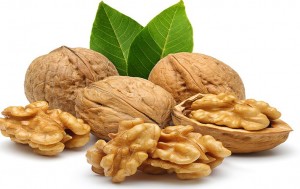Walnuts are edible kernels obtained from tree belonging to the Juglandaceae family, in the genus, Juglan. The nuts have been revered since ancient times as the symbol of intellectuality since their bi-lobed kernels inside the hard shell feature convoluted surface resembling as that of the human brain! They enriched with many health-benefiting nutrients, especially omega-3 fatty acids that are essential for optimum health. 
Juglan species plants are medium sized, semi-tropical, deciduous trees believed to be originating in the mountain ranges of Central Asian or southern Europe region.
There at least 30 different cultivars types of walnut grown world-over. However, only three popular varieties grown for their commercial purposes are English or Persian walnut (Juglans regia), Black walnut (Juglans nigra), and the White or butternut walnut (Juglans cinerea). Commercially, they are being cultivated in the United States of America, Romania, France, Turkey, and China. After plantation, the tree takes approximately four years until it produces its first major crop.
During each season, walnut fruits can be ready for harvest by August, when their thick green hull (thin-cover) begins to crack open to expose light brown, hard-shelled “walnut” inside. Each nut features roughly spherical shape, about the size of a medium-sized lemon, weighing about 10-15 g, and enclosing single (bi-lobed) edible kernel inside.
Structurally, the walnut kernel consists of two uneven, off-white color corrugated lobes, covered by a papery thin, light brown skin. The lobes loosely attached to each other at center.
Oil extracted from the walnut kernels has been employed as base or carrier oil in medicine, and in aromatherapy, apart from cooking.
Health benefits of Walnuts
- Walnuts are rich source of energy and hold several health benefiting nutrients, minerals, antioxidants and vitamins that are essential for optimum health and wellness.
- They are rich source of monounsaturated fatty acids (about 72%) like oleic acid and an excellent source of all important omega-3 essential fatty acids such as linoleic acid, alpha-linolenic acid (ALA) and arachidonic acids. Regular consumption of walnuts in the diet, therefore, may help in lowering total as well as LDL or “bad cholesterol” and increases HDL or “good cholesterol” levels in the blood. Research studies suggest that Mediterranean diet which is rich in mono-unsaturated fatty acids, and omega-3 fatty acids may help cut-down risk of coronary artery disease, and strokes by favoring healthy blood lipid profile.
- Eating as just as an handful (25 g) of walnuts every day can provide about 90% of RDI (recommended daily intake) of omega-3 fatty acids. Research studies suggest that n-3 fatty acids by virtue of their anti-inflammatory actions may help lower blood pressure, cut-down coronary artery disease and stroke risk, and offer protection from breast, colon and prostate cancers.
- Additionally, they are rich source of many phyto-chemical substances that may contribute to their overall anti-oxidant activity, including melatonin, ellagic acid, vitamin E, carotenoids, and poly-phenolic compounds. These compounds known to have potential health effects against cancer, aging, inflammation, and neurological diseases.
- Further, they are an excellent source of vitamin E, especially rich in gamma-tocopherol; carry about 21 g per 100 g (about 140% of daily-required levels). Vitamin E is a powerful lipid soluble antioxidant, required for maintaining the integrity of cell membrane of mucus membranes and skin by protecting it from harmful oxygen-free radicals.
- They are also packed with several important B-complex groups of vitamins such as riboflavin, niacin, thiamin, pantothenic acid, vitamin B-6, and folates.
- They also very are rich source of minerals such as manganese, copper, potassium, calcium, iron, magnesium, zinc, and selenium. Copper is a cofactor for many vital enzymes, including cytochrome c-oxidase and superoxide dismutase (other minerals function as co-factors for this enzyme are manganese and zinc). Zinc is a co-factor in many enzymes that regulate growth and development, sperm generation, digestion, and nucleic acid synthesis. Selenium is an important micronutrient, which functions as a co-factor for anti-oxidant enzymes such as glutathione peroxidases.

- Walnut oil has flavorful nutty aroma and exhibits excellent astringent properties. When applied locally it helps keep skin well protected from dryness. It has also been employed in cooking, and as “carrier or base oil” in traditional medicines in massage therapy, aromatherapy, in pharmaceutical and cosmetic industry.
- Munch a handful of walnuts a day and you will get enough of recommended levels of minerals, vitamins, and protein.
Culinary uses
- Walnut kernels can be enjoyed as they are, without any seasoning/additions. Use nutcracker machine to cut open its hard, outer shell. The kernels can also be enjoyed roasted, salted, or sweetened.
- The kernels have nutty yet pleasantly sweet in taste. Add them as toppings on yogurt, pizzas, pies, etc.
- Crushed kernels often sprinkled over salads, desserts, particularly sundaes and other cream based preparations.
- Candied walnuts can be added as seafood toppings.
- They used extensively in the confectionery, as an addition to biscuits, sweets, and cakes.
- The nuts are also used to make walnut-butter, which is quite popular; especially among peanut allergies.



